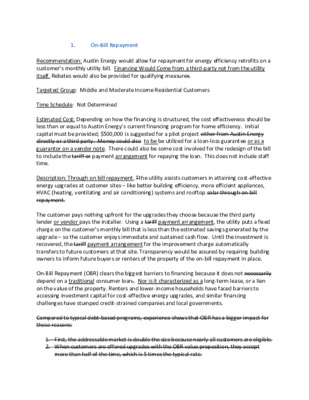Item 3a-Revised On Bill Repayment Recommendation_Cyrus Reed — original pdf
Backup

1. On-Bill Repayment Recommendation: Austin Energy would allow for repayment for energy efficiency retrofits on a customer’s monthly utility bill. Financing Would Come from a third-party not from the utility itself. Rebates would also be provided for qualifying measures. Targeted Group: Middle and Moderate Income Residential Customers Time Schedule: Not Determined Estimated Cost: Depending on how the financing is structured, the cost effectiveness should be less than or equal to Austin Energy’s current financing program for home efficiency. Initial capital must be provided; $500,000 is suggested for a pilot project either from Austin Energy directly or a third party. Money could also to be be utilized for a loan-loss guarantee or as a guarantor on a vendor note. There could also be some cost involved for the redesign of the bill to include the tariff or payment arrangement for repaying the loan. This does not include staff time. Description: Through on bill repayment, Tthe utility assists customers in attaining cost-effective energy upgrades at customer sites – like better building efficiency, more efficient appliances, HVAC (heating, ventilating and air conditioning) systems and rooftop solar through on-bill repayment. The customer pays nothing upfront for the upgrades they choose because the third party lender or vendor pays the installer. Using a tariff payment arrangement, the utility puts a fixed charge on the customer’s monthly bill that is less than the estimated savings generated by the upgrade – so the customer enjoys immediate and sustained cash flow. Until the investment is recovered, the tariff payment arrangement for the improvement charge automatically transfers to future customers at that site. Transparency would be assured by requiring building owners to inform future buyers or renters of the property of the on-bill repayment in place. On-Bill Repayment (OBR) clears the biggest barriers to financing because it does not necessarily depend on a traditional consumer loan,. Nor is it characterized as a long-term lease, or a lien on the value of the property. Renters and lower-income households have faced barriers to accessing investment capital for cost-effective energy upgrades, and similar financing challenges have stumped credit-strained companies and local governments. Compared to typical debt-based programs, experience shows that OBR has a bigger impact for these reasons: 1. First, the addressable market is double the size because nearly all customers are eligible. 2. When customers are offered upgrades with the OBR value proposition, they accept more than half of the time, which is 5 times the typical rate. 3. When customers do accept, the projects they undertake are much larger because the terms are more attractive. Precedents: States with utilities conducting some type of OBR program include AR, CA, CT, HI, KS, KY, NJ, NY, and SC. In Texas, Guadalupe Valley Electric Co-operative uses OBR to collect air conditioning service charges on the monthly bill. The Pedernales Electric Coop is developing an OBR program to finance PVs. Austin Energy’s “Nightwatchman” program that leases lighting equipment as part of a security lighting electric rate goes back to 1979. This rate and program are similar to a number of utilities around the country. Program Design, Customer Protection and Other Issues: An On-bill Repayment program will require important design characteristics, including program objectives, target market, financial product structuring, program administrator (be it Austin Energy or a third party), capital source, credit enhancements, customer eligibility requirements, project eligibility requirements, installation, marketing and the amount of incentives (ie rebates). The projects should be revenue-neutral and aimed at saving at least 10% of total energy use. Both homeowners and renters could be considered. The Task Force believes that the middle-income and moderate-income residential market may be an important target group, since this group does not qualify for free weatherization, but with a combination of rebates and on-bill repayment could enjoy significant savings. Additional customer protections Austin Energy should consider in the design of any OBR program include: • Partial payments are applied first to utility bills with any funds left over credited to the repayment of the loan; • No collection action from Austin Energy except to collect revenue from billing and transfer to vendor; • If the savings estimated in developing the fixed loan repayment charge are not realized, the fixed charge should be adjusted dollar for dollar in order for the customer to realize the estimated savings; • No disconnection for failing to pay the fixed loan charge included in the billing for energy efficiency improvements; • Fixed loan charges should be left out of balance billing and payment arrangements, and handled separately from utility billing arrangements; • Clear guidelines on contract for services if applied to tenants; and • Clear guidelines on how tenants are informed about loan charge on their bill before they sign a lease, potentially through the ECAD. Potential models to look at include Clean Energy Works Oregon, New York On-Bill Recovery Loan Program and Kansas’ How$mart program.1 While some of these programs are On-Bill Financing programs where the utility actually finances the work, the recommendation we are making would utilize third-party financing with repayment on the energy bill.2 The Task Force reiterates that there should be no disconnection for non-payment of the loan, utilizing more standard collection measures, and utilizing a loan-loss reserve account if payment is not secured. 1 American Council on Energy Efficiency Economy, On-Bill Financing for Energy Efficiency Improvements, April 2012, http://aceee.org/files/pdf/toolkit/OBF_toolkit.pdf 2 Environmental Defense Fund, On-Bill Repayment Fact Sheet, https://www.edf.org/sites/default/files/obr-program-fact-sheet.pdf.